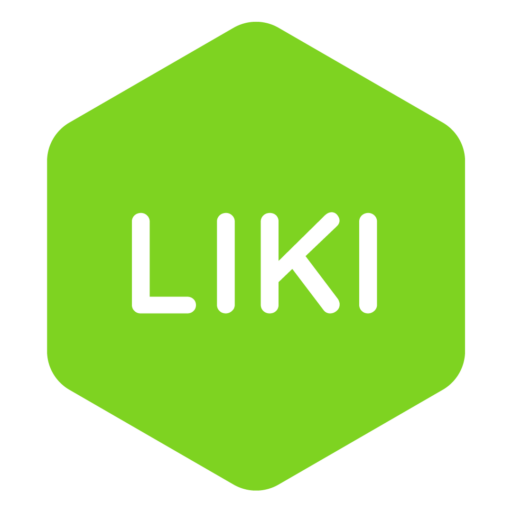ORION – AI Assistant for Critical Infrastructure Management in Crisis Situations for Companies and Public Institutions
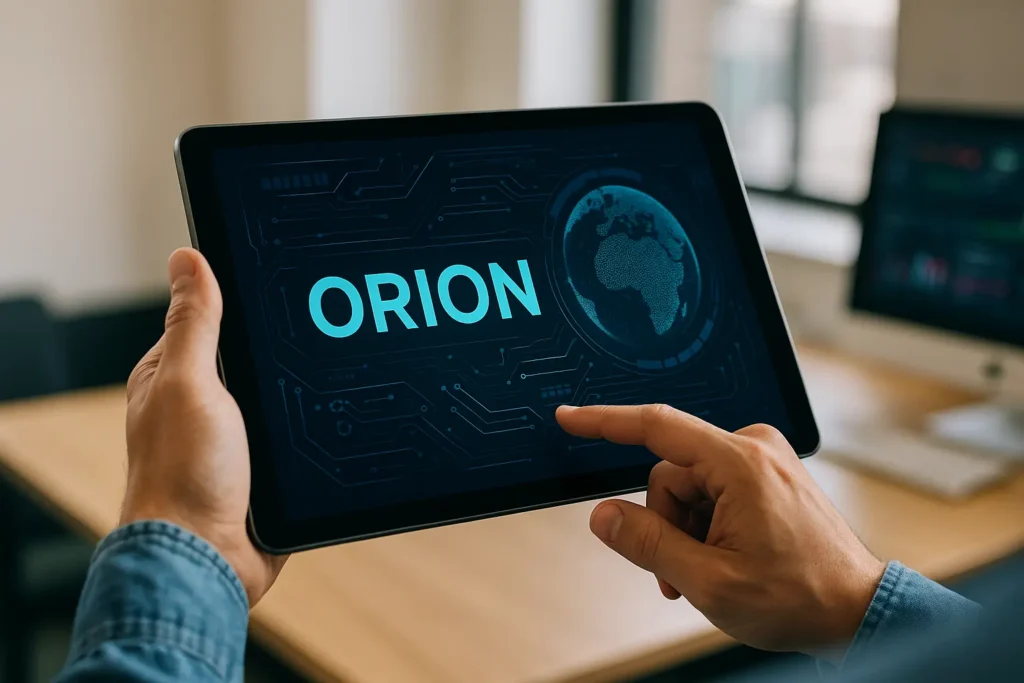
The ORION system is a dual-use solution designed to support organizations in two parallel realities:
- In everyday operations: it helps improve energy and operational efficiency by analyzing diagnostic data from installations and supporting informed decision-making.
- In crisis situations: it operates locally and independently
of the internet, supporting organizational continuity and reducing risk.
We have created an Environmentally Aware Artificial Intelligence
that uses real-world data and can autonomously influence the environment in real time.
ORION consists of:
- AI Agent: a local LLM-based chatbot that understands sensor data and can respond in real time.
- IoT Edge System: collects, analyzes, and utilizes infrastructure data (energy, water, air, security).
- Control Module: capable of executing recommended actions, such as shuttting off water, activating ventilation, or switching power sources.
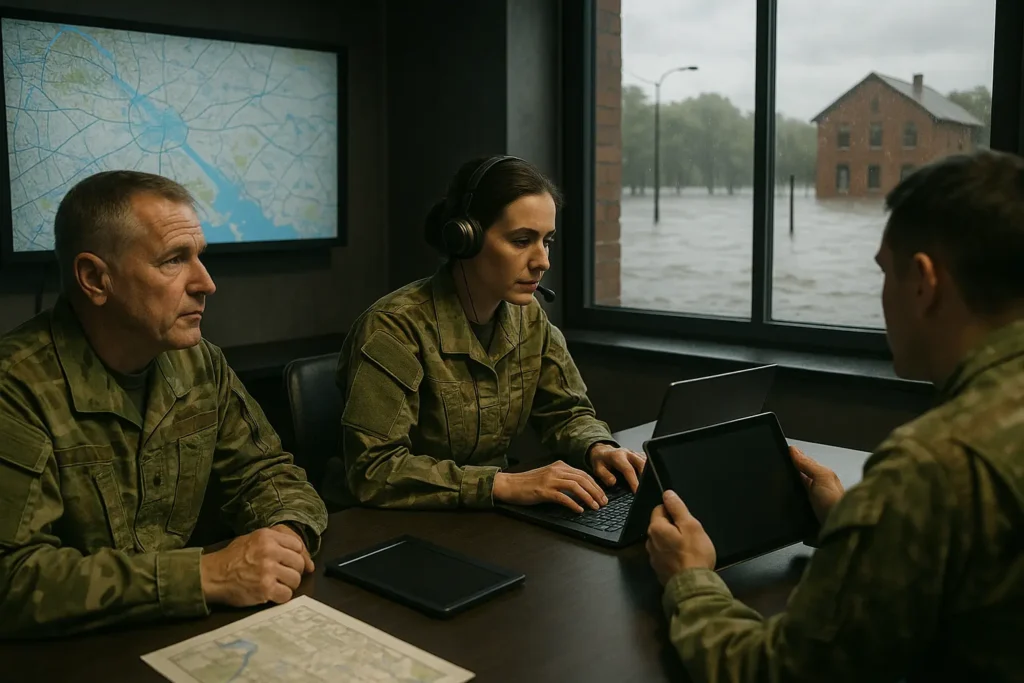
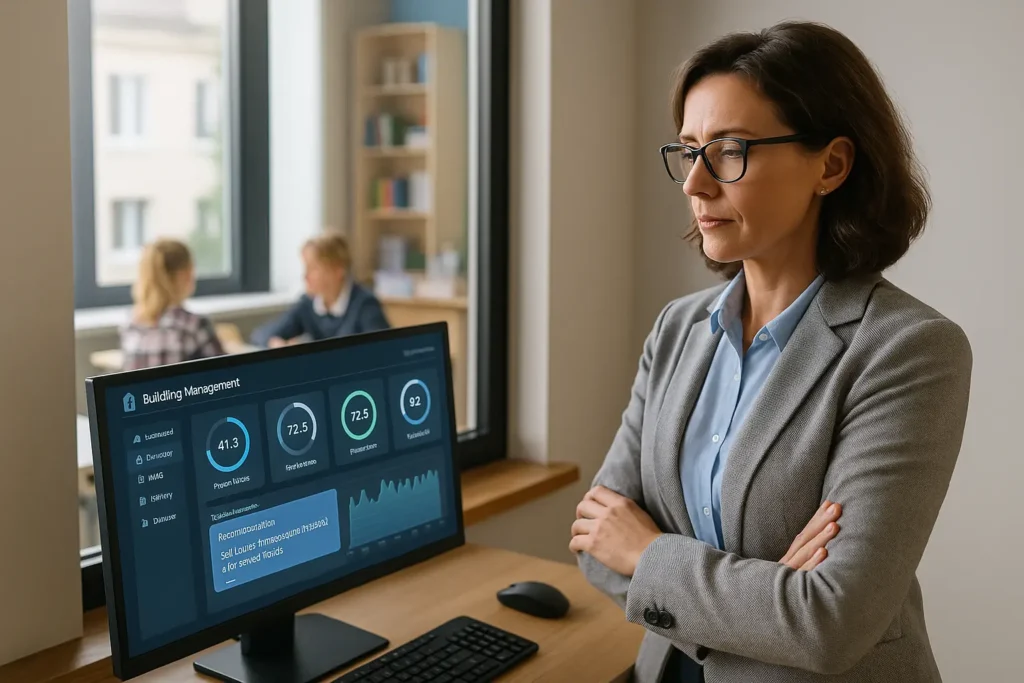
Why Implement ORION?
Implementing the ORION system is a strategic decision for organizations seeking true operational resilience – not only in response to everyday challenges, but also in the face of extreme threats such as natural disasters, hybrid warfare, infrastructure sabotage, or wartime scenarios.
ORION is designed to support private companies, public administration units, and critical infrastructure operators in conditions where standard systems cease to function. It operates independently of the internet, locally and in real time, enabling decision-making and response even in total isolation from external networks – making it a key tool in scenarios involving military threats or national destabilization.
ORION serves both as a digital advisor and as an autonomous operator reacting to events in the physical environment. It combines a locally deployed language model (LLM), a network of IoT sensors, and actuator modules capable of automatically responding – shutting down power, controlling HVAC systems, blocking water valves, or switching building operation modes.
Unlike traditional analytics and management systems, ORION is built to operate in two realities – everyday and crisis. In the first, it supports cost optimization, maintenance planning, and resource consumption analysis. In the second, it protects lives, infrastructure, and data – even in the face of war, cyberattacks, or major natural disasters.
Below are the key benefits of implementing ORION.
Enhanced Safety for People and Infrastructure
ORION continuously monitors data from building and infrastructure systems – including temperature, voltage, humidity, gas concentrations, motion, human presence, and air quality. Based on this data, it can detect early signs of fire, gas leaks, electrical overloads, or hydraulic failure risks. In dangerous situations, it can immediately take action – for example, cutting off power or water supply, activating ventilation, or restricting access to hazardous zones.
The system can also make automatic decisions when reaction time is critical – without needing human intervention. ORION operates autonomously, locally, and effectively, even when standard procedures fail due to network loss or cloud disconnection.
Early Fault Detection and Reduced Downtime
Thanks to real-time AI-driven diagnostics, ORION can identify anomalies in equipment and system performance before a breakdown occurs. This enables proactive maintenance planning, reducing costs, eliminating downtime, and improving operational efficiency.
For instance, the system might detect reduced cooling efficiency in a building and suggest checking filters or energy usage. It can also warn of rising reactive power consumption, pointing to a need for power supply configuration adjustments.
Optimization of Energy and Resource Use
ORION continuously monitors the consumption of electricity, water, gas, and other resources, analyzing usage in relation to work schedules, outside temperatures, building usage types, and other variables. It generates simple, practical recommendations – e.g., turning off ventilation after working hours or reducing power during certain times of day.
It’s a tool that directly impacts operational and environmental costs – without requiring in-house energy specialists.
Data-Driven Decision Support
With a conversational interface powered by a local language model, users can interact with ORION as if speaking to an expert. Instead of reviewing charts and reports, they can simply ask: “Where was the biggest increase in electricity usage last week?” – and receive a clear, actionable answer with data sources and suggested actions.
This radically shortens analysis and decision-making time while reducing the risk of errors due to oversight or lack of analytical expertise.
Resilience Against Connectivity Loss and Internet Disruptions
ORION is designed to function without internet access, during network disruptions, and even in full isolation from the cloud. Its entire logic – including the AI engine – runs locally on the ORION Node server, which integrates all components into a closed, resilient environment.
It supports LoRa networks, campus 5G, Wi-Fi, Zigbee, and standard Ethernet – ensuring redundancy and stability, even in critical situations.
That’s why ORION meets modern standards of operational resilience and can be used by institutions in sensitive areas such as civil protection, emergency response, critical infrastructure, and local government.
Intuitive Interface Accessible to Everyone
ORION enables full system functionality without the need for a dedicated IT team. Its clear and logical conversational interface allows users to ask questions or request analyses in natural language – and the system will respond, take action, or generate a report.
This design makes ORION accessible to a wide range of users – from building managers and administrative staff to field technicians.
Compliance with the Civil Protection Act (Journal of Laws 2024, item 1907)
The ORION system addresses the needs defined in the Civil Protection Act effective as of December 5, 2024.
It supports local governments, public institutions, and companies managing critical infrastructure in fulfilling new obligations related to:
monitoring protective infrastructure (e.g., shelter and evacuation buildings),
managing crisis situations and evacuations,
ensuring business continuity and operational resilience in threat scenarios.
The system is compliant with Articles 36–135 of the Act and can be financed from local government budgets, government programs, and targeted grants.
LiveObjects
Integrated LiveObjects Dashboards – The ORION system utilizes professional LiveObjects dashboards that not only enable remote infrastructure management but also offer advanced data visualization, trend analysis, and parameter correlation. This allows operators to better understand the real-time situation and make faster, more accurate decisions.
Everyday Use and Proven Reliability – The dashboards are used daily in operational work, ensuring both stability and intuitive operation.
Preparedness for Crisis Situations – In the event of a public network outage or crisis, the ORION panel remains accessible within the local infrastructure (closed network), ensuring continuity of operations and access to critical information without an internet connection.
Off-line

On-line

ORION in Educational Institutions
Everyday Use – Improving Efficiency and Environmental Conditions
In educational institutions — such as primary schools, high schools, kindergartens, and universities — ORION serves as an intelligent energy and environmental advisor. It supports school directors, facility administrators, and local governments in efficiently managing buildings, controlling costs, and improving learning conditions.
ORION analyzes data from multiple sources: temperature and humidity sensors, HVAC systems, energy meters, weather data, class schedules, and timetables. This allows it not only to monitor consumption, but also to understand the context of how an educational building operates — when and how it’s used, how many people are present, and whether systems are functioning as intended.
Based on this analysis, ORION can:
- Identify inefficiencies in resource usage, such as heating at full power during nights or weekends when the school is empty. The system suggests specific actions — e.g., automatically lowering the temperature by 2°C after 6:00 p.m. — and provides estimated savings.
- Optimize ventilation and air conditioning based on occupancy levels and current weather conditions, improving comfort for students and teachers while reducing unnecessary electricity use.
- Manage energy from photovoltaic installations, monitoring production and consumption in real time and adjusting systems (e.g., battery charging, power distribution) to maximize self-consumption.
- Generate reports and insights for school authorities, directors, and administrators, clearly showing where and why excessive costs arise and what actions lead to savings.
Thanks to this, ORION offers tangible support for budget optimization, improved learning environments, and compliance with sustainable energy management requirements in public institutions.
Emergency Use – Support in the Event of War, Natural Disasters, or Sabotage
ORION is designed as a dual-use solution, meaning it functions not only during peacetime but also in extraordinary and crisis situations. For educational institutions, this means the ability to respond effectively and make informed decisions even when the health or lives of students, teachers, and staff are at risk.
In the event of a natural disaster (e.g., flooding), sabotage, war, digital infrastructure failure, or a blackout — ORION remains fully operational thanks to its local architecture and offline capabilities, with no need for internet access or external systems.
In crisis scenarios, the system:
- Identifies buildings suitable for evacuation or temporary shelter – analyzing sensor data in real time to indicate which facilities have power, running water, are outside hazard zones, and have working ventilation and independent heating sources.
- Continuously monitors critical parameters, such as water levels in basements, gas concentration in rooms, temperature, humidity, and air quality. This information is delivered directly to facility management, without the need to dispatch staff into potentially dangerous areas.
- Automatically secures infrastructure – it can shut off power in specific zones, cut water supply, or activate emergency ventilation systems to reduce the risk of fire, flooding, or contamination.
- Supports the operations of local authorities and emergency services – by generating reports, threat maps, and analyses of building status and locations that can be used as shelters, temporary care centers, or backup government offices.
Through these capabilities, ORION significantly increases the operational resilience of the education system – enabling schools and institutions not only to function more efficiently and comfortably on a daily basis but also to act safely and autonomously during real emergencies.
Application of the ORION system in industry and critical infrastructure
Everyday Use – Operational Optimization and Predictive Maintenance
In manufacturing plants, factories, logistics centers, and other industrial facilities, ORION functions as an advanced digital operator for infrastructure processes. In daily operations, it supports maintenance teams, energy managers, automation specialists, and operational managers in maintaining high technical efficiency while keeping operational costs as low as possible.
ORION analyzes real-time data from hundreds of measurement points – including energy and water meters, temperature, humidity, and pressure sensors, power quality analyzers, HVAC systems, and industrial automation. Based on this data, it:
- Detects early signs of equipment and system failures – such as abnormal increases in power consumption, pressure spikes, motor instability, or loads exceeding acceptable thresholds. Instead of waiting for a breakdown, the system recommends scheduled maintenance, component replacement, or machine configuration adjustments.
- Identifies energy inefficiencies – pinpointing specific workstations, lines, or devices with excessive energy use, such as high reactive power, low cooling efficiency, or operation outside scheduled hours.
- Optimizes resource consumption – taking into account changing production conditions, seasonality, planned downtimes, or workload peaks. ORION dynamically adjusts its recommendations and alerts the team when consumption deviates from norms, along with suggested corrective actions.
- Manages self-consumption of renewable energy – by collecting data from photovoltaic panels, energy storage systems (batteries, UPS), and meters of current demand and usage. ORION matches the facility’s energy profile to available local resources, enabling real savings on energy bills and reducing the load on the external grid.
All these functions are accessible through a conversational interface powered by a local AI model, which means that even users without analytical experience can operate the system – just ask a question, and ORION will provide a clear answer, report, or recommendation.
Emergency Use – Operation During War, Sabotage, or Natural Disasters
Industry is a critical component of every nation’s infrastructure — vital for both economic security and strategic resilience. That’s why ORION is also designed to operate under extreme conditions such as war, sabotage, blackouts, natural disasters, or digital isolation.
In crisis situations, the system:
- Takes control of key infrastructure processes, enabling continued operation of critical production lines even with limited access to power or communications. ORION manages energy priorities — shutting down non-essential loads and directing available resources where they are needed most.
- Notifies plant management about which halls, lines, or production areas are safe to use, based on data from environmental sensors, power systems, ventilation, gas detectors, fire detection systems, and emergency infrastructure (e.g. UPS systems, backup generators).
- Supports safe personnel evacuation and protects hazardous installations — ORION can automatically shut down or block systems that pose a threat during destabilization, such as pressure chambers, chemical tanks, or high-voltage equipment. This happens without the need for physical human presence.
- Integrates with local energy sources, allowing a factory to operate in island mode. This enables production to continue even if disconnected from the power grid — with energy supplied by photovoltaic panels, diesel generators, energy storage systems, or on-site microgrids.
Most importantly, all operations are executed locally, with no need for internet access or external control systems. ORION functions independently, making it one of the few solutions capable of full offline operation — essential in the event of cyberattacks, physical damage to telecom infrastructure, or wartime scenarios.
ORION in Educational Institutions
Everyday Use – Rationalizing Spending and Supporting Management
In the day-to-day operations of public administration units – such as municipal, county, or city offices and subordinate institutions – the ORION system supports the rational management of public assets, optimization of operating costs, and the achievement of sustainable development (ESG) goals.
ORION integrates data from various buildings and locations – including schools, kindergartens, sports facilities, government offices, community centers, cultural venues, and event halls – analyzing:
- utility consumption (electricity, water, gas),
- environmental parameters (temperature, humidity, CO₂),
- facility occupancy, usage hours, and external conditions.
Based on this data, the system:
- Identifies locations with the highest energy losses and recommends specific cost-saving actions, such as lowering temperatures outside working hours, turning off lighting during certain times, or adjusting heating schedules based on event calendars.
- Facilitates the implementation of municipal energy and climate policies – analyzing data from photovoltaics, heat pumps, and other distributed renewable energy sources to support self-consumption and local energy independence.
- Generates clear reports for facility managers, mayors, boards, and council members, showing measurable results of implemented actions – for example, the percentage drop in energy consumption in a given building after applying system recommendations.
- Levels the playing field between institutions – with a conversational interface and explanations of technical terms (e.g., reactive power, thermal hysteresis, CO₂ ppm), ORION enables every user – regardless of technical background – to understand and make informed decisions.
All of this makes ORION not only a cost-optimization tool but also a way to elevate public sector management standards and transparently report environmental initiatives.
Emergency Use – Crisis Management and Civil Protection
ORION is also a tool designed to operate in emergency situations where traditional procedures and infrastructure may fail – such as during floods, terrorist attacks, infrastructure sabotage, war, or disconnection from the power and telecommunications grid.
In such scenarios, local government units (LGUs) become crisis management centers – and ORION supports them at every stage:
- Rapid selection of buildings suitable for sheltering evacuees – ORION analyzes real-time data from schools, gyms, halls, or community centers: whether running water, electricity, heat sources are available, if ventilation systems function correctly, and whether the building is located outside the danger zone. This allows the selection of optimal locations without sending personnel into the field, protecting staff from physical danger and drastically accelerating decision-making.
- Remote coordination of public facilities – the system enables control over power, water, ventilation, building access, and environmental parameters, even when internet networks or centralized systems are no longer operational.
- Protection of LGU critical infrastructure – ORION can automatically cut power in buildings at risk of flooding, fire, or power supply failure, reducing the risk of secondary damage. It can also coordinate the operation of generators, UPS systems, and small-scale renewable energy installations, providing basic power supply in selected locations.
- Operation in isolation conditions – the system runs locally, without internet, accessible via internal networks (LAN, LoRa, campus 5G), allowing it to function even in wartime or full digital isolation of a region.
Thanks to this, ORION becomes a real support tool for crisis response teams, emergency management, and command centers, combining environmental, technical, and location data into one coherent source of knowledge – always available, always current, always ready to act.
What ORION Can Do
ORION combines a range of advanced functions and technologies to provide comprehensive user support:
- Local AI Processing: All computational intelligence runs on-site — on servers or devices at the client’s location. This keeps data secure within the organization and allows the system to function even without cloud access.
- Connectivity Resilience: ORION is designed to operate independently of the internet. It uses local databases and AI models, so in the event of a network outage, it continues to monitor, analyze, and provide guidance without interruption.
- Conversational Interface: The system includes a built-in voice and text assistant. Users can communicate with ORION in natural language — asking questions (“Is everything normal in Building A?”) or issuing commands (“Show energy network status”) — and the system understands the intent, providing answers or relevant data. It can also integrate with Augmented Worker software with an AI module, enabling hands-free voice control in the field — ideal for technical teams and infrastructure operators working in challenging conditions.
- Sensor and System Integration: ORION gathers information from existing building management systems (BMS), IoT sensors, cameras, and databases. It consolidates scattered data into a unified view of the situation. It can integrate with both modern equipment and legacy software, creating a central infrastructure knowledge hub.
- Data Analysis and Prediction: Using machine learning and advanced analytics, ORION detects patterns and anomalies in data. It can predict future events — such as increases in energy demand, upcoming component wear, or potential failures — enabling proactive planning and problem prevention.
- Action Recommendations: Based on collected data and AI insights, ORION suggests concrete actions for personnel. It may recommend safety procedures (e.g., step-by-step evacuation), optimal device settings (to save energy), or maintenance schedules. Each recommendation is backed by data, helping staff make informed final decisions.
- Scalability and Modularity: ORION’s architecture allows starting with a small pilot and expanding gradually. Additional functional modules (e.g., energy management, security, urban analytics) can be added as new needs arise. The system easily supports increasing numbers of devices and data volumes as the project grows.
- High Level of Cybersecurity: ORION uses advanced cybersecurity mechanisms developed by Fuse AI, ensuring data protection and resilience against attacks.
How to Implement ORION?
The “Quick Win & Scale” Strategy in Practice
Implementing advanced, modular, and strategic systems like ORION requires a well-thought-out methodology. In response to the need for fast value delivery with minimal risk, ORION is based on the “Quick Win & Scale” approach — a phased deployment strategy that delivers measurable benefits early on, while allowing the system to grow in line with the organization’s actual needs.
This approach not only lowers the entry barrier and initial costs, but also enables the effective testing of key functions in real-world conditions. It helps build trust among users and leadership, and supports the development of a scaling model based on hands-on experience — not theory.
Stage 0 – Digital Maturity Audit and Risk Analysis
The implementation of the ORION system is always preceded by an initial diagnostic phase, aimed at determining:
- the current level of digital maturity within the organization,
- which key processes and infrastructure components are most critical to protect,
- which assets (data, systems, buildings, personnel) are most sensitive to disruptions,
- what realistic threat scenarios exist — from blackouts and cyberattacks to natural disasters or geopolitical instability.
At this stage, a priority map is also developed — identifying which areas offer the fastest return on investment and to what extent the organization intends to use ORION (daily management, infrastructure resilience, automated response, offline operation).
The result is a jointly developed implementation roadmap, tailored to the organization’s size, nature, and strategic goals.
Stage 1 – Quick Start: Cloud-Based Deployment
At this stage, the basic version of ORION is deployed in a cloud model. Using the client’s existing infrastructure (sensors, BMS, SCADA systems, meter or IoT data), the system is integrated into the organization’s real operational environment.
As part of the quick start, it is possible to:
- Launch a conversational AI assistant that understands the data and provides recommendations
- Begin monitoring utility consumption in selected locations
- Detect anomalies (e.g. leaks, excessive usage, devices operating outside scheduled times)
- Generate environmental reports and analyses
- Test emergency scenarios — such as simulated power outages or loss of internet connection
Deployment in this model is fast (a few weeks), cost-controlled, and enables users to immediately experience how ORION works and what specific benefits it brings.
This is the phase for building trust and delivering tangible value — serving as a launchpad for future scaling.
Stage 2 – Evaluation of Results and Development Plan Alignment
After several weeks or months of operating the cloud-based system, an evaluation of the implementation is conducted. This includes:
- Analysis of achieved savings and operational outcomes
- Assessment of the quality of decisions supported by AI
- Identification of barriers and areas requiring further automation or local control
- User feedback: Is the interface intuitive? Are the recommendations clear? Do users feel an improvement in comfort or safety?
At this stage, a development plan is created — outlining which locations should be included in the next phase of deployment, whether a local (offline/edge) version is needed, and which integrations should be prioritized (e.g., with security systems, traffic management, or SCADA).
Stage 3 – Full-Scale Deployment (Edge + On-Premise)
In this phase, ORION transitions from the cloud to a fully local, resilient operating model designed to function independently of the internet and public cloud services.
This stage includes:
- Installation of ORION Node servers (so-called Edge AI Rugged Servers) equipped with a local LLM (Language Model) and knowledge base
- Integration with technical infrastructure and building management systems (BMS, HVAC, power, security, ventilation)
- Activation of autonomous control – enabling the system to independently respond to threats or execute recommended actions
- Implementation of alternative communication channels (LoRa, campus 5G, Zigbee, Wi-Fi, Ethernet), ensuring operational continuity in conditions of digital isolation
At this point, the system gains full independence, becoming an autonomous operational center — capable of functioning in any scenario, including war, sabotage, or complete disconnection from national systems.
Stage 4 – Maintenance, Learning, and Development
ORION is not a closed project – it is a living system that evolves with the organization. In this final stage:
- Continuous monitoring of system effectiveness is carried out
- The AI learns from real-life events – every incident, failure, or crisis enriches both the local and global knowledge base
- Experience and data sharing is enabled through the ORION Resilience Network – a community of institutions that collaborate on resilience strategies and crisis response insights
Maintenance also includes technical support, security updates, and ongoing AI development – including integrations with new data sources, new types of devices, and the organization’s evolving needs.
Why Implement in Phases?
The “Quick Win & Scale” model allows you to:
- Start with the most profitable and visible areas, making it easier to gain internal support for the investment
- Avoid unnecessary spending and technological overkill – the system grows only where it delivers value
- Test operational resilience in practice, not just on paper
- Minimize investment risk by moving in small but consistent steps
- Gradually engage the team, increasing acceptance, understanding, and internal competence across the organization
Summary
Implementing the ORION system doesn’t require a revolution. Thanks to the “Quick Win & Scale” methodology, any organization – from a school, to an industrial facility, to a city hall – can begin the journey toward digital resilience quickly, safely, and cost-effectively.
It’s not just a way to manage better today – it’s an investment in survival and operational capability for tomorrow.
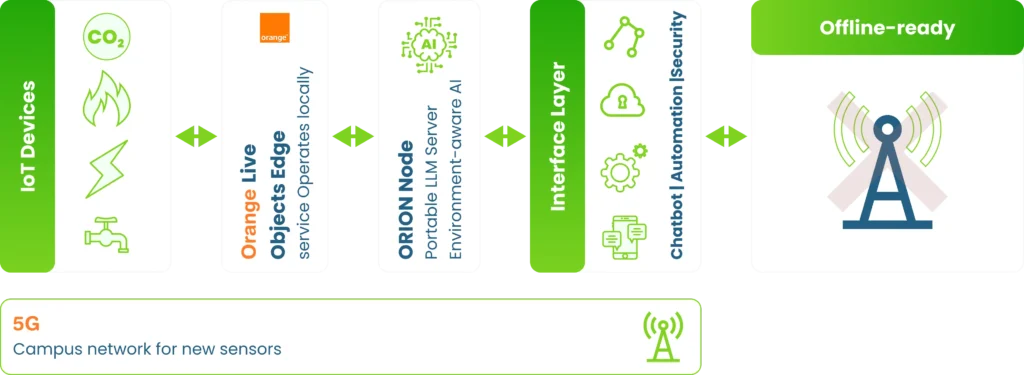
Why Implement ORION with Us?
The decision to implement the ORION operational resilience system is an investment in your organization’s safety, independence, and efficiency. But just as important as the system itself is the quality of the implementation — how it is planned, executed, scaled, and maintained. That’s why choosing the right partner for the journey is crucial.
Below, we outline why implementing ORION with us makes a difference — because we’re not just a technology provider, but a team that designs and delivers solutions with your real-world challenges in mind.
1. We Truly Understand What Operational Resilience Means
Operational resilience isn’t just about backups and evacuation plans. It’s the ability to function despite disruption, make decisions under uncertainty, ensure process continuity, and truly mitigate the impact of crises — whether it’s a blackout, war, sabotage, cyberattack, or climate disaster.
Thanks to our knowledge and experience:
- We build systems that keep working even when everything else fails
- We design architectures resilient to communication breakdowns, network isolation, or power loss
- We integrate solutions that not only analyze data, but take action to protect infrastructure and people
2. We’re Not Just an Integrator – We’re Co-Creators of ORION
Our role goes far beyond installing a ready-made system. We are the team actively developing and refining ORION — both technologically and conceptually. This means:
- We know every component of the solution, including its capabilities and limitations
- We can tailor the system to your specific needs, rather than simply “deploying a template”
- We have direct influence over the functional roadmap, security, integrations, and AI module development
As a result, your feedback doesn’t disappear into a support inbox — it goes straight to the product team.
3. We Implement Step by Step – Transparently and with Long-Term Thinking
The “Quick Win & Scale” model we use isn’t just a trendy concept. It’s a proven project approach in which:
- We first work with you to select an area where ORION will deliver the fastest, measurable impact (e.g., a specific school, production hall, or municipal building)
- Then we launch a pilot deployment — without unnecessary bureaucracy, using your data and infrastructure
- Finally, we jointly decide on the pace and scope of scaling the system, guided not by technological ambition, but by real business and operational value
This means that from the very first weeks:
- You get a working solution
- You maintain clear cost control
- You avoid overwhelming your team or facing user resistance
4. We Work Locally and Align with European Standards
ORION is designed and developed within the European Union, using components that comply with EU/NATO security requirements and the principles of digital sovereignty. As a team:
- We use Polish or European language models (e.g., PLLuM, Mistral)
- We collaborate with public and industrial sector partners, fully aware of their legal and operational constraints
- We understand the specifics of national infrastructure (energy, education, administration, industry)
- We are locally present – we meet with you, run joint workshops, and implement the system side by side with your team
We’re not a deployment firm from overseas — we’re a partner who understands the local context and takes responsibility on the ground.
5. We Combine Expertise from Multiple Worlds
Our team brings together experts from a variety of fields:
- IoT and edge computing engineers – responsible for physical integration of sensors and devices
- Critical infrastructure and security specialists – who know how to build systems resilient to failures and attacks
- AI and LLM developers – who design the assistant’s logic, ensure the quality of its recommendations, and manage data processing
- Digital transformation consultants – who translate “technology” into organizational change and real business value
That’s why implementing ORION with us isn’t just an installation — it’s a strategic project built with a full understanding of your organization’s context.
6. We Invest in Your Team and Its Skills
Every ORION implementation is not just about system setup — it’s about knowledge transfer and building internal capabilities. We train your team to:
- Understand infrastructure data
- Work effectively with conversational AI
- Make decisions based on environmental, energy, and operational data
- Prepare the organization for crisis scenarios
We also support you in developing procedures, response strategies, integration with your BCP (Business Continuity Plan), and in conducting simulations and tests.
7. We Don’t Just Promise — We Show
You don’t have to take our word for it. We can:
- Show you a system demo using your own data
- Run a hands-on workshop with your team
- Launch a pilot at a selected site in just a few weeks
See how ORION works in practice. Watch what it suggests to your team. Experience the value — firsthand.
Implementation Costs
Basic implementation + first year of operation:
from 9 000 EUR to 46 000 EUR net
The cost depends on:
- the scale of integration,
- number of locations,
- AI and IoT requirements,
- level of customization.
Annual fee for maintenance, support, and licensing:
from 9,000 EUR to 21 000 EUR net / year
Includes:
- Ongoing technical and service support
- AI and security component updates
- Maintenance of RAG infrastructure and LLM model
- Participation in the ORION Resilience Network community
Additional (optional) costs, based on evaluation plan:
- IoT equipment compatible with Orange LiveObjects Edge
- Deployment of private 5G campus networks
- ORION Node Server
- Extensions for new locations and institutions
- Integration with SCADA, SOC, BMS, and SIEM systems
The ORION system can be implemented in phases — using a quick start and evaluation model (“quick win”) — with the flexibility to scale according to the organization’s needs and digital maturity.
ORION RESILIENCE NETWORK Community
Resilience Is Not a Product. It’s a Process. And a Process Needs People.
In a world full of unpredictable threats — from extreme weather events and cyberattacks to geopolitical instability — having a tool is not enough. You also need competence, experience, and access to proven solutions.
That’s why, alongside the ORION system, we are building the ORION RESILIENCE NETWORK — a community of users, experts, and institutions who share knowledge, learn from one another, and work together to raise security standards.
This is not a typical “customer group.”
It’s a practical, action-oriented environment where collaboration, shared experience, and operational resilience truly matter.
What Does the ORION RESILIENCE NETWORK Community Offer?
- Knowledge and Best Practice Sharing
Members of the network share:
- Implementation models and recommended ORION system configurations
- Integration schemes with various types of infrastructure (education, industry, public administration, logistics)
- Experiences in responding to real crisis events
- Best practices in energy management, environmental analysis, and fault prediction
We are building a repository of ready-to-use solutions that can be adapted, implemented, and expanded across different organizations. Knowledge doesn’t sit on a shelf — it flows between participants.
- Joint Resilience Exercises and Response Testing
We organize:
- Simulations of crisis scenarios (blackout, flood, infrastructure attack)
- Business Continuity Plan (BCP) workshops with experts from the public and industrial sectors
- Inter-agency cooperation tests (e.g., shared management of public buildings during evacuation)
- Analysis of findings and implementation of recommendations in ORION systems across the network
As a result, system users are not only technologically equipped, but also operationally trained.
- Secure Collaboration Between Institutions
The ORION RESILIENCE NETWORK enables:
- Sharing selected data and analyses between institutions — e.g., between city halls and schools, counties and hospitals, operators and municipalities
- Building shared predictive models — trained on data from multiple users, but operating locally and autonomously
- Creating local micro-resilience networks — for example, between municipalities collaborating on crisis management
This collaboration is based on principles of data sovereignty, transparent access, and full compliance with EU regulations (GDPR, NIS2).
- Access to Funding and Joint Projects
Members of the community can:
- Jointly apply for EU and national funding (e.g., Horizon Europe, Digital Europe, Cohesion Funds, FENiKS)
- Conduct pilot programs and research within cross-sector consortia
- Use the technical and expert resources of the network when preparing project documentation
The community acts as a financial and organizational lever, enabling the implementation of projects that would be difficult to achieve individually.
- Continuous Improvement of ORION Technology
Each network member:
- Can influence the development of the ORION system — suggest features, participate in beta testing
- Gains access to the latest extensions, updates, and educational materials
- Helps shape the direction of the entire operational resilience ecosystem
ORION is not a rigid product — it’s a platform co-developed with its users, adapting to real-world conditions rather than imposing them.
Who Is This Community For?
The ORION RESILIENCE NETWORK is open to:
- Local government units,
- Schools and educational institutions,
- Industrial facilities and infrastructure operators,
- Private companies focused on business continuity,
- Crisis management and public safety institutions.
If your organization uses ORION or plans to implement it, you become part of a community that acts—not just talks.

Jan
CEO

Przemek
COO

Kasia
Digital Value Manager

Piotr
Business Representative

